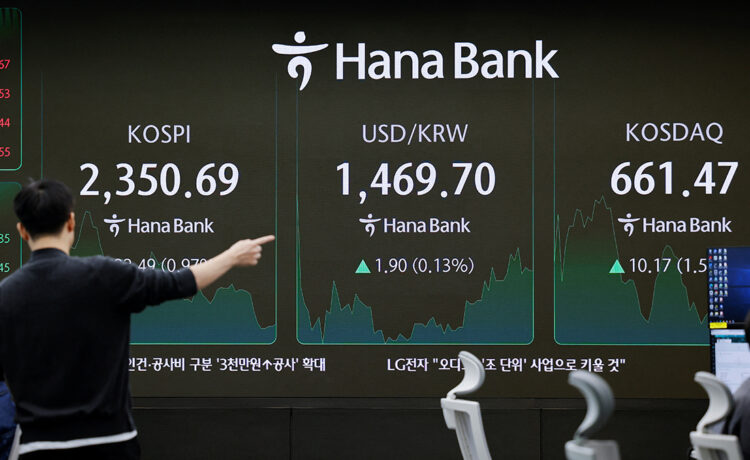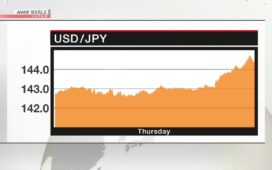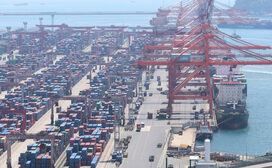On President Donald Trump’s much-touted April 2 “Liberation Day,” he unveiled a range of potentially debilitating “reciprocal” tariffs on the United States’ major trading partners—and most other countries as well. Surprisingly, some of the countries facing the highest tariffs after the April announcement were U.S. partners in Asia, such as Japan, South Korea, and Vietnam; Vietnam, a huge trading partner, was hit with a 46 percent “reciprocal” tariff. Trump also put tariffs on Cambodia—a whopping 49 percent for one of East Asia’s poorest countries—and even Australia, a critical security ally that has a trade surplus with the United States.
What’s behind Trump’s proposed tariff policy?
More From Our Experts
After the bond markets dropped precipitously in response to his initial “reciprocal” tariffs, Trump temporarily paused many of the higher tariffs on countries other than China. The U.S.-China tariff-raising contest that has since followed has led to both countries placing more than 100 percent levies on the other’s products and goods.
More on:
Despite delaying many of his “Liberation Day” plans, Trump has not wiped out all tariffs. His remaining near-universal 10 percent tariffs on virtually all imports, combined with the massive duties on China, have created the highest average U.S. tariff rate since 1901, when tariff battles grew and later contributed to the Great Depression. U.S. consumers and companies now face roughly 28 percent tariffs on imports overall. This is in stark contrast with the 2 percent average tariffs during President Joe Biden’s administration.
The White House claims the tariffs will build an alliance of states that will reduce trade with China in exchange for favorable trade conditions for the U.S. and partners. Instead, the tariffs could heighten Asian states’ belief that Washington is not a trustworthy partner, since the “reciprocal” tariffs make no economic sense and they are not as used to Trump’s volatility and anger as Europe. China is also not sitting idly by. Since Trump’s tariff announcement, Chinese President Xi Jinping embarked on a tour of Southeast Asia—visiting Cambodia, Malaysia, and Vietnam—where he signed several economic cooperation agreements.
Meanwhile, Trump recently announced he is considering new tariffs on imported medicines after slapping tariffs on long-time foes and close allies. No matter a country’s ties to the United States, the unpredictability of these actions could badly weaken Asia’s economic confidence in Washington. This shift could also seriously affect U.S. defense relationships in Asia, weakening U.S. hard power and creating strategic instability.
More From Our Experts
Ultimately, the unstable tariff policies could also lead many Asian economies already involved in regional economic integration to distance themselves from the United States and pursue closer trade ties with China and the European Union (EU). This shift could leave China as the regional, and possibly global, economic hegemon.
Why are many Asian economies particularly exposed to higher tariff rates?
Beginning in the 1950s and 1960s, many East Asian countries pursued export-oriented industrialization, a development strategy that made many reliant on foreign markets to sell products, especially the giant U.S. consumer market. Some, such as China and Japan, also relied on sizable domestic markets, but even these giants were major exporters to the United States—at least until recent years, as they have sought out more diversified export markets. This export-oriented model vastly increased the gross domestic product (GDP) of countries including South Korea and Vietnam. Although these increasingly wealthy Asian states have signed trade deals and found new markets across the world, many still rely on exports to the United States.
More on:
In the years after Trump was first elected—well before he attempted to force states to isolate China by imposing expansive tariffs—some of these economies began to develop defenses against new U.S. trade barriers. For example, Australia broadened export markets beyond the United States and China. Others, such as China, also built supply chains that relied less on imports.
Why did Trump target these Asian countries?
The White House’s policies will also upend a decade of bipartisan government efforts aimed at encouraging U.S. companies to move away from China to places such as Malaysia, Mexico, Thailand, and Vietnam. For several years, U.S. politicians and economists have raised concerns that reshoring was disguising continued Chinese exports. Often, Asian countries such as Vietnam assemble and ship products to the United States but use components sourced from China. By doing this, multinational companies and China avoid tariffs or other restrictions. The current Trump administration has sought to punish many of these U.S. companies and countries that facilitated this sleight-of-hand that has allowed China to dodge U.S. tariffs.
Moreover, Trump’s worldview is a product of the 1980s. Japan became wealthier in per capita income [PDF] than the United States during that decade and began to take over major U.S. companies. This created an uneasy relationship between the two countries. Among other purchases, Japan’s conglomerate Sony bought the fabled U.S. film production company Columbia Studios, and Japanese automaker Mitsubishi bought Rockefeller Center, a major U.S. landmark. At the time, Trump repeatedly called for high tariffs against Japan and complained it was taking advantage of the United States.
His continued belief that the United States is being taken advantage of by its trade partners and love of tariffs still forms a central part of his trade policy—particularly toward Asia.
How are Asia-Pacific governments responding?
Asia’s poorest countries, as well as those with massive trade imbalances and limited leverage, are trying to meet Trump’s demands to reduce the severity of the proposed tariffs. For instance, Cambodia sells low-end manufactured goods to the United States and does not have the wealth to buy many U.S. products, but it relies on exports and is working to purchase more American goods to lower tariffs. Leaders in Vietnam, which has the third-largest U.S. trade surplus in the world, have already yielded to the White House’s demands by vowing to buy more American-made goods and signing a new trade deal with Washington.
Bigger Asia-Pacific economies have more options. Japan’s trade negotiator was recently in Washington to try to remove tariffs on Japanese products. Though he left without a deal, one tactic Tokyo used, according to Japanese officials, was to give Washington a subtle warning about the amount of U.S. debt it owns—Japan controls the most of any country. The slump in the U.S. bond market after some foreign investors dumped U.S. bonds helped spark Trump’s pause on tariffs. (Foreign investors are continuing to dump U.S. bonds.)
Australia and South Korea, after upcoming elections, are both likely to be run by left-leaning governments whose leaders have presented themselves as anti-Trump fighters. They are expected to tighten economic links with China and seek closer economic ties with the EU, among others. Malaysia and Thailand, smaller economies that face Trump’s ire, likely will move further into China’s economic orbit as well. Both are signing a wide range of investment and trade cooperation with Beijing.
Overall, the larger Asian economies, as with other big trading partners and investors in the United States and its equity and bond markets, are rattled by the lack of certainty. The Trump administration is regularly floating new tariffs, making it unclear what will happen after the pause on “reciprocal” tariffs or how the U.S.-China trade war will develop. The United States is no longer seen by some trading partners as a safe haven for future direct, equity, or bond investment. It is unclear if Washington can ever undo this negative sentiment.
How is China responding?
China is already part of major trade frameworks in Asia that the United States pulled out of or never joined. For example, China, but not the United States, is part of the Regional Comprehensive Economic Partnership (RCEP), the largest trading bloc in the world.
Beijing has moved quickly to build on its already-large trade and economic advantages in Asia—it has been Southeast Asia’s top trading partner for the past sixteen years—and to seize on the many opportunities presented by Trump’s tariffs on Asia-Pacific states. It is already trying to put a hammerlock on regional economics, such as being the central actor in the RCEP and often using economic coercion against countries like Australia it has disputes with.
Asian nations’ distrust of the United States as a stable partner is not only trade related, as Washington is gutting the region in multiple ways. The tariffs, after all, come after the Trump administration destroyed the U.S. Agency for International Development, which spent more than $800 million just in Southeast Asia last year.
Beijing is now promoting itself in the region as the only stable economic power left in the world, and it has ramped up aid and foreign investment to shore up the vacuum left by the United States. China has also quietly worked with Japan and South Korea on plans to dramatically increase trade among the three and warmed ties with Australia, wooing Canberra with much greater bilateral trade. It has done much to promote the idea of new trade routes as well, proposing a link between East Asian economies and European commerce via the Chinese mainland.
On a bilateral basis, China has also employed a diverse toolkit beyond just responding in kind to Washington’s tariffs, such as restricting rare earth minerals exports to the United States. This is a resource that the United States has little of domestically, yet needs much of for its most high-tech products. This is only one tactic, and President Xi has made clear that he believes China has the domestic innovation, manufacturing strength, reserves, and popularity to outlast the United States in a trade war.
Xi could have a point. Though it is true that firms could respond to the proposed “reciprocal” tariffs by reconsidering China as a manufacturing base, they could also find it a cheaper bet if tariffs remain high on other countries. Asian states will look to other places to sell goods and services, make trade deals, and perhaps even use other currencies than the dollar to settle deals if they have to. Through his trade war, Trump could see the world economic order transformed—but the United States could come out not as the winner.
Will Merrow created the graphics for this article.





